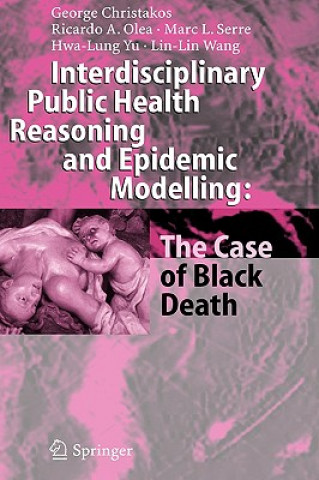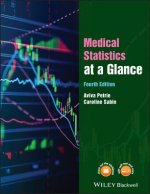
Kód: 01560617
Interdisciplinary Public Health Reasoning and Epidemic Modelling: The Case of Black Death
Autor George Christakos, Ricardo A. Olea, Marc L. Serre
This multidisciplinary reference takes the reader through all four major phases of interdisciplinary inquiry: adequate conceptualization, rigorous formulation, substantive interpretation, and innovative implementation. The text in ... celý popis
- Jazyk:
 Angličtina
Angličtina - Vazba: Pevná
- Počet stran: 320
Nakladatelství: Springer-Verlag Berlin and Heidelberg GmbH & Co. KG, 2005
- Více informací o knize

3313 Kč

Skladem u dodavatele v malém množství
Odesíláme za 12-17 dnů
Potřebujete více kusů?Máte-li zájem o více kusů, prověřte, prosím, nejprve dostupnost titulu na naši zákaznické podpoře.
Přidat mezi přání
Mohlo by se vám také líbit
Dárkový poukaz: Radost zaručena
- Darujte poukaz v libovolné hodnotě a my se postaráme o zbytek.
- Poukaz se vztahuje na celou naši nabídku.
- Elektronický poukaz vytisknete z e-mailu a můžete ihned darovat.
- Platnost poukazu je 12 měsíců od data vystavení.
Více informací o knize Interdisciplinary Public Health Reasoning and Epidemic Modelling: The Case of Black Death
Nákupem získáte 331 bodů
 Anotace knihy
Anotace knihy
This multidisciplinary reference takes the reader through all four major phases of interdisciplinary inquiry: adequate conceptualization, rigorous formulation, substantive interpretation, and innovative implementation. The text introduces a novel synthetic paradigm of public health reasoning and epidemic modelling, and implements it with a study of the infamous 14th century AD Black Death disaster that killed at least one-fourth of the European population.This book introduces a novel synthetic paradigm of public health reasoning and epidemic modelling, and then implements it in the study of the infamous 14th century AD Black Death disaster that killed at least one-fourth of the European population. §The book starts by focusing on the intellectual context in which epidemic research takes place, in a way that accounts for the interdisciplinary and multicultural trends of the emerging Conceptual Age. The authors maintain that for public health scientists to function in an often complex environment, they should be aware of the divergent conceptions of knowledge and the technological changes that these imply, the multiple and often uncertain databases available and their reliability, the different styles of thinking adopted by the disciplines involved, and the importance of developing sound interdisciplinary knowledge integration skills. A unique feature of the book is that it takes the reader through all four major phases of interdisciplinary inquiry: adequate conceptualization (in terms of metaphors, methodological principles, epistemic rules, and argumentation modes), rigorous formulation (involving sophisticated mathematical models), substantive interpretation (in terms of correspondence principles between form and meaning), and innovative implementation (using advanced systems technology and multi-sourced real world databases). This approach is then applied to scientifically advance the spatiotemporal characterization of the Black Death epidemic, thus going beyond the sensationalistic narration of events found in other publications.§The book includes the most complete collection of interdisciplinary information sources available about the Black Death epidemic, each one systematically documented, tabulated, and analyzed. It also presents, for the first time, a series of detailed space-time maps of Black Death mortality, infected area propagation, and epidemic centroid paths throughout the 14th century AD Europe. Preparation of the maps took into account the uncertain nature of the data and integrated a variety of interdisciplinary knowledge bases about the devastating epidemic. These maps provide researchers and the interested public with an informative and substantive description of the Black Death dynamics (temporal evolution, local and global geographical patterns, etc.), and can help one discover an underlying coherence in disease distribution that was buried within reams of contemporary evidence that had so far defied quantitative understanding. The book carefully analyzes the findings of synthetic space-time modelling that enlighten considerably the long-lasting controversy about the nature and origins of the Black Death epidemic. Comparisons are made between the spatiotemporal characteristics of Black Death and bubonic plague, thus contributing to the debate concerning the Black Death etiology. Since Black Death had grave societal, public health, and financial effects, its rigorous study can offer valuable insight into these effects, as well as into similar effects that could result from potential contemporary epidemics.
 Parametry knihy
Parametry knihy
Zařazení knihy Knihy v angličtině Medicine Medicine: general issues Public health & preventive medicine
3313 Kč
- Plný název: Interdisciplinary Public Health Reasoning and Epidemic Modelling: The Case of Black Death
- Autor: George Christakos, Ricardo A. Olea, Marc L. Serre
- Jazyk:
 Angličtina
Angličtina - Vazba: Pevná
- Počet stran: 320
- EAN: 9783540257943
- ISBN: 3540257942
- ID: 01560617
- Nakladatelství: Springer-Verlag Berlin and Heidelberg GmbH & Co. KG
- Hmotnost: 1440 g
- Rozměry: 235 × 155 × 23 mm
- Datum vydání: 24. June 2005
Oblíbené z jiného soudku
-

Glucose Revolution
356 Kč -

The Art & Science of Foodpairing
1042 Kč -

Encyclopedia of Bach Flower Therapy
716 Kč -

Nutrition and Physical Degeneration
926 Kč -

China Study: Revised and Expanded Edition
357 Kč -

Gut
254 Kč -

Energy Paradox
544 Kč -

It's All in Your Head
306 Kč -

Nutrition and Physical Degeneration
955 Kč -

Manual of Dietetic Practice 6e & Dietetic Case Studies Set
3677 Kč -

Close Your Mouth
329 Kč -

Body Awareness as Healing Therapy
349 Kč -

Bio-identical Hormones and Telomerase
589 Kč -

Inner Level
306 Kč -

Causal Inference for Statistics, Social, and Biomedical Sciences
1704 Kč -

Integrative and Functional Medical Nutrition Therapy
3927 Kč -

Nutrition for Sport, Fitness and Health
3308 Kč -

Marijuana Medicine
697 Kč -

Nutrition for Sport and Exercise - A Practical Guide
1534 Kč -

Mikronährstoff-Räuber: Metformin
131 Kč -

Oxford Handbook of Clinical Medicine
1527 Kč -

Rewire Your Anxious Brain
444 Kč -

Worry Trick
424 Kč -

Why We Eat (Too Much)
306 Kč -

Miller's Review of Critical Vaccine Studies
438 Kč -

Bella Figura
250 Kč -

Spillover
305 Kč -

Neurosonology and Neuroimaging of Stroke
4541 Kč -

I Think You'll Find It's a Bit More Complicated Than That
357 Kč -

Decision Modelling for Health Economic Evaluation
2018 Kč -

Cancer Revolution
393 Kč -

Healer Within
416 Kč -

Statin Nation
303 Kč -

Fundamentals of Clinical Trials
1702 Kč -

Medical Statistics at a Glance 4th Edition
1056 Kč -

Evidence-Based Medicine
1124 Kč -

Physics of Miracles
344 Kč -

Never Too Late to go Vegan
424 Kč -

MSM Miracle
246 Kč -

Protein Structure, Stability, and Folding
3313 Kč -

Gordis Epidemiology
1413 Kč -

Clinical Studies in Medical Biochemistry
1866 Kč -

Nutrition & Diagnosis-Related Care
5610 Kč -

No One Cares About Crazy People
473 Kč -

Health Behavior -Theory, Research, and Practice 5e
2290 Kč -

Galen on Food and Diet
1697 Kč -

Marketing Nutrition
3559 Kč -

Oxford Handbook of Applied Bayesian Analysis
2212 Kč -

Cure Tooth Decay
899 Kč
Osobní odběr Praha, Brno a 12903 dalších
Copyright ©2008-24 nejlevnejsi-knihy.cz Všechna práva vyhrazenaSoukromíCookies




 Vrácení do měsíce
Vrácení do měsíce 571 999 099 (8-15.30h)
571 999 099 (8-15.30h)